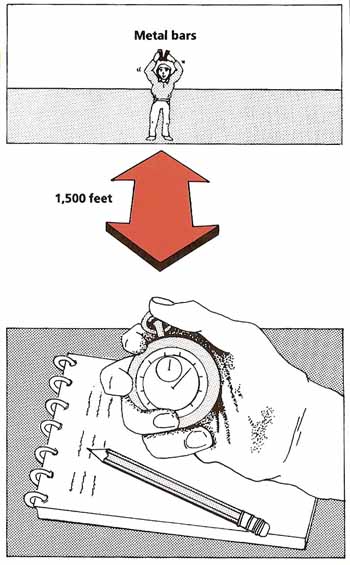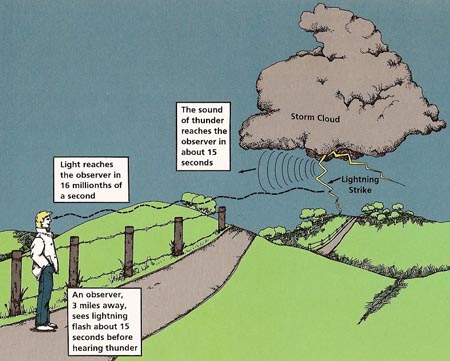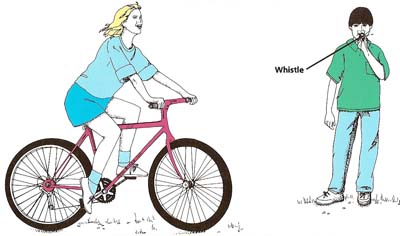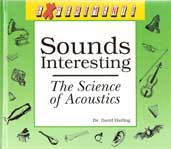SOUNDS INTERESTING: The Science of Acoustics - 5. Through the Sound Barrier

Figure 1. Experiments to measure the speed of sound.

Figure 2. Thunder and lightning.

Figure 3. How a sonic boom is formed.

Figure 4. Experimenting with the Doppler Effect.

Figure 5. Doppler effect.
Strange though it may seem, all the sounds you can hear were made in the past. The reason for this is that it takes sound waves time to travel from one place to another. So, any sound reaching your ears now began its journey a short while ago – in the past.

The Speed of SoundYou will need:
What to do:
Measure a distance of 1,500 feet as accurately as possible. Ask your assistant to stand at one end of the marked distance holding a metal bar in each hand. Stand at the other end, holding the stopwatch and watching your assistant through binoculars. When you shout "Go!" your assistant should crash the two bars together above his or her head, as loudly as possible. As soon as you see the two bars meet, start the watch and as soon as you hear the sound, stop the watch (see Figure 1). Record the time to the nearest tenth of a second. Repeat this ten times. Find the average time by adding up all the measured times and dividing by ten. To work out the approximate speed of sound, divide the distance (1,500 feet) by your average time. |
Thunder and Lightning
The speed of sound in air, under normal conditions, is about 1,100 feet per second or 750 miles per hour. That may seem fast, but it is about a million times slower than the speed of light (which is over 186,000 miles per second!) This big difference between the speed of sound and the speed of light explains why we normally see lightning well before the thunder that was created at the same time (see Figure 2).
If a storm is two miles away, the flash of lightning from it will reach us in less than one ten-thousandth of a second – that is, almost instantly. However, the rumble of the accompanying noise will take over nine seconds to travel the same distance, In fact, by measuring the interval between the thunder and the lightning, we can work out roughly how far the storm is from us.
Sonic Booms
A supersonic aircraft is one that can travel faster that the speed of sound. As the plane approaches the speed of sound, it catches up with the sound waves traveling in front of it and pushes them up against each other. The result is a barrier of squashed air in front of the aircraft. As the plane reaches the speed of sound, it breaks through this barrier and causes the squashed air to spread out rapidly behind in a powerful SHOCK WAVE (see Figure 3). When the shock wave reaches the ground, people hear a noise like a loud clap of thunder. This so-called sonic boom may have enough force to shatter windows.

A Change of PitchYou will need:
What to do:
Ask the assistant to take a deep breath and blow the whistle steadily while you ride quickly toward and past him or her on the bicycle (see Figure 4). What happens to the sound of the whistle as you go past? Can you think of any way to explain what happens? |
The Doppler Effect
As a police car or ambulance passes you, with its siren wailing, the sound of the siren seems to drop to a lower note. This is due to something known as the Doppler Effect, named after the Austrian scientist Christian Johann Doppler, who discovered the reason for it in 1842 (see Figure 5).
Doppler found that if a source of sound is moving, the sound waves are crowded together in front of it and spread apart behind it. Squeezing sound waves together increases their frequency, while spreading them lowers their frequency. As a result, to someone at rest the sound will seem higher when the source is approaching and lower when it is moving away.
At the time when Doppler announced his findings, there was no easy means to test them. The fastest form of transport which carried a horn was the horse-drawn mail coach. This only moved at about ten miles an hour – too slow for the Doppler Effect to be noticeable. It was only in 1845, when a scientist took a trumpet aboard a train locomotive, that the effect was first demonstrated.

